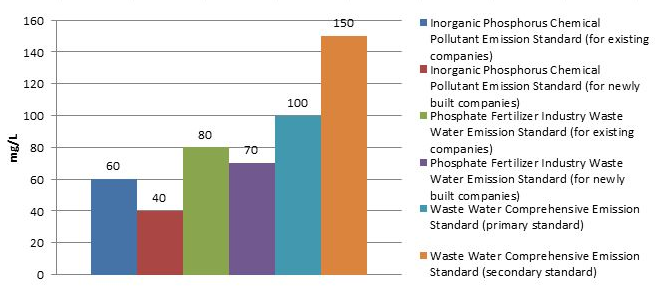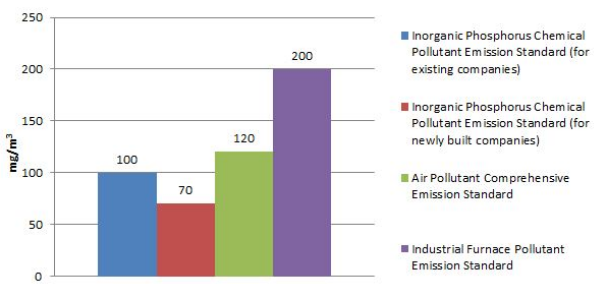The Inorganic Phosphorus Chemical Pollutant Emission Standard was submitted to the MEP recentyly. CCM predicted that the new standard is expected to be put into effect as early as in 2017. It is said that requirements are more stringent.
On 9 Oct., 2015, the Inorganic Phosphorus Chemical Pollutant Emission Standard (the Emission Standard) which was jointly formulated by the Ministry of Environmental Protection of the People’s Republic of China (the MEP), the China Inorganic Salts Industry Association (CISIA) and Jiangyin Chengxing Industrial Group Co., Ltd., etc., has already been summated to the MEP and is expected to be put into effect as early as in the beginning of 2017.
As the first special comprehensive standard that controls the emission of waste water and waste gas of the inorganic phosphorus chemical industry in China, the Emission Standard integrates the Yellow Phosphorus Industrial Pollutant Emission Standard, the Phosphate and Phosphorus Chemical Industrial Pollutant Emission Standard, the Air Pollutant Emission Standard of Phosphorus Chemical Industry (under formulation) as well as maximum emission limits of inorganic phosphorus chemical waste water.
Regarding the emission of waste water, there are 11 indexes, including PH value, suspended solids, chemical oxygen demand (COD), total phosphorus, total nitrogen, fluoride, etc. Besides, benchmark water discharge volume of unit product is set.
Regarding the emission of waste gas, there are 7 indexes for yellow phosphorus companies, covering particulate, sulfide, sulfur dioxide, fluoride, total phosphorus of gaseous state, P2O5, arsenic and its chemical compound; there are 6 indexes for other inorganic phosphorus chemical companies: particulate, sulfur dioxide, fluoride, P2O5, chlorine hydride, arsenic and its chemical compound. Besides, benchmark waste gas discharge volume of unit product is also set.
Specifically, the Emission Standard allows a transition period of two years for inorganic phosphorus chemical companies. In other words, if the Emission Standard is put into implementation in 2017, original existing companies will have to meet the new standards by 2019 and as for those companies built after the implementation of the Emission Standard, their emission should reach the new standards before they are approved to be set up.
It is reported that stricter requirements have been put forward for the emission of tail gas of yellow phosphorus production and the waste water generated from the production of phosphorus chemicals in the Emission Standard. For example:
- For the emission of COD content in waste water from inorganic phosphorus chemical companies, the maximum emission limit is 60 mg/L for existing companies and 40 mg/L for newly built companies (the primary standard sat in the Waste Water Comprehensive Emission Standard is 100 mg/L);
- For the emission of particulate content from yellow phosphorus companies, the maximum emission limit is 100 mg/m3 for existing companies and 70 mg/m3 for newly built companies (that in the Air Pollutant Comprehensive Emission Standard is 120 mg/m3).
Maximum emission limits of COD in waste water in China

Source: CCM & government document
Maximum emission limits of particulate of yellow phosphorus companies in China

Source: CCM & government document
CCM believes that the Emission Standard is in line with the developing phosphorus chemical production technologies. It will boost the integration of the industry and exert positive impact upon environmental protection in China.
First of all, pollutant control technologies of the phosphorus chemical industry have been developing and the existing emission standards have become out-of-data to some extent.
Nowadays, comprehensive utilization of tail gas of yellow phosphorus is no longer a fairy tale. In fact, comprehensive utilization technologies have been improving.
For instance, the project of application and catalytic purification of yellow phosphorus tail gas was awarded the second prize of national technological innovation of 2014 in China. According to relevant statistics, this technology has become very mature as of the beginning of 2015. It has occupied 21.5% of the market shares and covered over 40.6% of the total capacity of yellow phosphorus in China.
As a further example, the yellow phosphorus tail gas purification technology by dissolvent selective absorption process that jointly developed by Hubei Xingfa Chemicals Group Co., Ltd. and the Wuhan University early in 2010, has already been able to make the hydrogen sulfide (H2S) content and the total phosphorus content less than 10 mg/Nm3 respectively. (Nm3 refers to the gas volume at 1 normal atmosphere pressure under the temperature of 0 degree centigrade.)
Secondly, the Emission Standard conforms with the state’s adjustment to the phosphorus chemical industry and the future development direction of the industry.
Cost of building, upgrading and operating environmental protection devices will increase significantly after the Emission Standard is put into effect. This is unbearable for many small and medium companies. As a result, it will boost another new integration of the industry as small companies will be eliminated and utilization rate of production resources will be improved in large scale companies.
According to the deputy secretary-general of the CISIA and the project leader of the Emission Standard, Wen Lining, to meet the new standards, it takes about USD3.15 million (RMB20 million) to control tail gas generated from the production of 10,000 t/a yellow phosphorus.
Besides, according to the CISIA’s estimate, investment into environmental protection will account for about 5%-7% of the total investment of devices and the environmental protection operation cost will take up for about 1.5%-3% of the total production cost. As a whole, the fixed investment into the control of waste gas and water of the whole industry will reach USD251.95 million (RMB1.60 billion) to USD314.95 million (RMB2 billion) and the operating cost will hit USD40.94 million (RMB260 million) to USD78.74 million (RMB500 million).
Thirdly, the implementation of the Emission Standard will exert positive impact on environmental protection in China.
Environmental protection is a basic state policy in China. As the new Environmental Protection Law of the People's Republic of China was put into effect in Jan. 2015, requirements on environmental protection have become more stringent and punishment for violating the law has become more severe. As an industry with heavy pollution, the phosphorus chemical industry gains much attention from the country. During the 12th Five-year Plan period, environmental protection indexes such as treatment of the three wastes (waste gas, waste water and industrial residue), clean production and environmental pollution trend were set up to guide the development of the phosphorus chemical industry.
There is no doubt that the 13th Five-year Plan which will be unveiled in middle or late October 2015 will accord special attention to environmental protection as well. So, the new emission standards are in accordance with Chinese basic state policy and it is conducive to easing environmental pollution problems in China.
About CCM:
CCM is the leading market intelligence provider for China’s agriculture, chemicals, food & ingredients and life science markets. Founded in 2001, CCM offers a range of data and content solutions, from price and trade data to industry newsletters and customized market research reports. Our clients include Monsanto, DuPont, Shell, Bayer, and Syngenta. CCM is a brand of Kcomber Inc.
For more information about CCM, please visit www.cnchemicals.com or get in touch with us directly by emailing econtact@cnchemicals.com or calling +86-20-37616606.